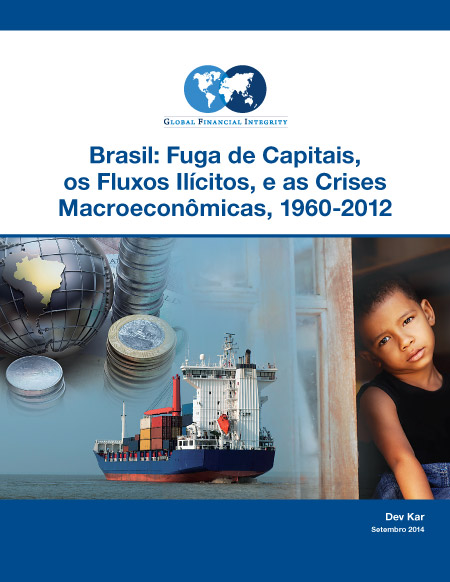This September 2014 study from Global Financial Integrity found that more than US$400 billion flowed illegally out of Brazil between 1960 and 2012—draining domestic resources, driving the underground economy, exacerbating inequality, and facilitating crime and corruption.
This report, which was funded by a grant from the Ford Foundation, is the fifth country case study released by Global Financial Integrity to date.
 Download Full Report |
 Baixar Versão em Português Baixar Versão em Português |
[wptab name=’Overview’]
Overview
Primary Findings
The Brazilian economy lost at least US$401.6 billion in illicit financial outflows from 1960 to 2012.
These outflows represent the proceeds of crime, corruption, and tax evasion, and have serious negative consequences for Brazil. Outflows were found to drain resources from the Brazilian economy, to drive the underground economy, and to exacerbate inequality.
Furthermore, the report found that illicit outflows are growing. Annual average illicit outflows increased from US$310 million in the 1960s to US$14.7 billion in the first decade of the twenty first century before jumping to US$33.7 billion over the last three years of the study, 2010-2012. On average, Brazil’s illicit outflows are equivalent to 1.5% of the country’s official GDP.
Trade misinvoicing is the major conduit of illicit financial flows from Brazil. The report reveals that the vast majority of Brazil’s illicit outflows—92.7%, or US$372.3 billion of the US$401.6 billion in total outflows—were channeled through the misinvoicing of trade transactions. The remaining US$29.4 billion in the illicit outflows detected by GFI occurred via hot money outflows, such as unrecorded wire transfers.
Policy Recommendations
GFI recommends a number of steps the Brazilian government can take to ameliorate the problem of illicit financial flows from the country revolving around two principles:
- Greater transparency in domestic and international financial transactions, and
- Greater cooperation between governments to shut down the channels through which illicit money flows.
These steps include taking stronger legal measures against trade misinvoicing, instituting transparency of company ownership, and building the technical and human capacity needed to effectively utilize the data that will be shared under emerging tax information exchange arrangements. GFI notes that the most important ingredient to curbing illicit financial flows from Brazil is generating the political will necessary to implement and enforce these measures.
Broad Capital Flight
In addition to estimating illicit outflows of capital from Brazil, the study also estimates that broad capital flight—a combination consisting of both licit and illicit outflows—amounted to US$590.2 billion between 1960 and 2012. Broad capital flight was found to average roughly 2.2% of Brazil’s official GDP over the study period.
Illicit outflows constituted 68% of total capital flight, and they were shown to drive broad capital flight from Brazil.
Underground Economy
The report estimated that the size of Brazil’s underground economy averaged 38.9% of official GDP over the 53-year period, increasing from an average of 45.8% in the 1960s to 55.1% in the 1970s before slowly falling to an average of 21.8% from 2010 through 2012, as a result of faster economic growth.
Methodology
This report utilizes the same methodology to calculate illicit flows as was used in GFI’s 2014 case study on the Philippines and in GFI’s 2013 global update on illicit financial flows. GFI cautions that the methodology is very conservative and that there are likely to be more illicit flows from Brazil that are not captured by the models. For example, a large amount of the proceeds of abusive transfer pricing between arms of the same multinational corporation as well as much of the earnings from drug trafficking, human smuggling, and other criminal activities—which are often settled in cash—are not included in these estimates.
Moreover, this report uses the largest Structural and Behavioral Equations Model developed by Dr. Kar to analyze the drivers and dynamics of Brazil’s illicit flows.
[/wptab]
[wptab name=’Read the Report’]
Read the Report
The full PDF of the report can be downloaded here. Additionally, the full report can be read in the Scribd window below.
[wptab1 name=’English’ set=’1′]
[/wptab1]
[wptab1 name=’Português’ set=’1′]
[/wptab1]
[end_wptabset1 set=’1′]
[/wptab]
[wptab name=’Acknowledgements’]
Acknowledgements
About the Author
Dev Kar is Global Financial Integrity’s Chief Economist, having formerly served as a Senior Economist at the International Monetary Fund.
Contributions
Brian LeBlanc assisted with the data analysis, and Joshua Simmons contributed to the policy analysis.
Raymond Baker, Christine Clough, Clark Gascoigne, Taylor Le, Channing May, and Melissa O’Brien also supported this project.
Funding
Funding for this report was generously provided by the Ford Foundation.
[/wptab]
[end_wptabset skin=”gray” location=”top” ]

